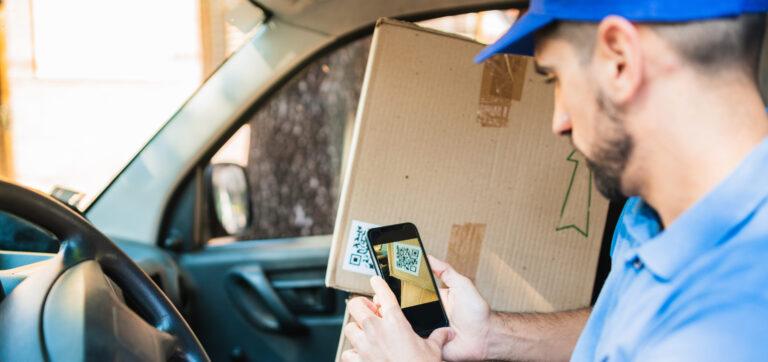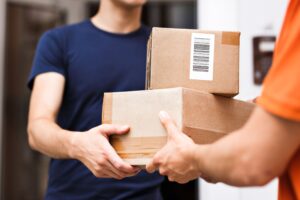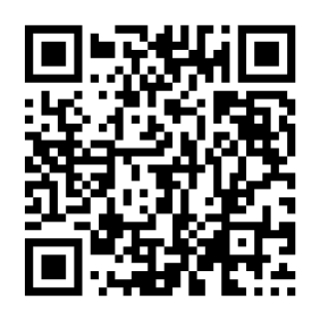The last years have left deep marks. Confronted with remote work, lockdowns, and social distancing, people changed their ways of living. When they couldn’t shop in person, they shifted to ordering online: The package delivery industry saw demand explode during the lockdown. Some of these effects persist to this day.
A constantly rising parcel volume is one of them. This presents a serious challenge for package delivery businesses, because customers still expect delivery within 2–3 business days at the same low cost.
Thus, peak times in last-mile delivery demand higher precision and efficiency at every stage of the value chain than ever before. The loading process of packages back at the parcel center, rising fuel and labor costs, and the pressure on drivers to perform well with no time to spare make last-mile delivery the most expensive, error-prone, and time-consuming part of the supply chain.
One way to simplify your employees’ workflows to save time and reduce costs is to integrate barcode scanner software into your company’s mobile app and let your employees work with smartphones.
Learn more about the benefits of mobile barcode scanning on the last mile in this article.
How to use smartphones in last-mile delivery
There are different approaches to using smartphones in last-mile delivery, from employees bringing their own devices to business-only phones. They differ in how much control the company has over the devices – which has far-reaching consequences.
Let’s now look at four basic device strategies – BYOD, CYOD, COPE, and COBO – and their advantages and disadvantages.
BYOD
The BYOD (“bring your own device”) strategy allows employees to use their own mobile devices for work purposes. It is widely used as it is both flexible and cost-effective.
The key advantage is that enterprises don’t need to purchase expensive hardware or invest in maintenance and storage. Furthermore, they don’t have to wait for device delivery and onboarding, as employees are already familiar with their devices.
However, there are some disadvantages to BYOD. Firstly, the sheer variety of devices makes it difficult to ensure compatibility. Additionally, device security is the employees’ responsibility. Consequently, handling sensitive work-related information on these personal devices inevitably raises security concerns.
An enterprise BYOD strategy must account for these issues. In doing so, it has to balance employees’ privacy rights against compliance with data protection laws and industry regulations.
CYOD
CYOD (“choose your own device”) trades some of BYOD’s flexibility for increased company control.
Here, employees choose their device from a premade selection. Because the company provides the mobile device, it decides what hard- and software is used, effectively erasing compatibility issues. Additionally, it has a say in implementing security measures.
Implementing CYOD does mean that a device inventory has to be stocked and maintained. However, the limited device pool means that maintenance work is relatively simple to plan.
COPE
COPE (“company-owned, personally enabled”) is similar to CYOD in that the company provides its employees with a mobile device. However, even though they are allowed to use them privately, employees cannot choose their devices. The private use familiarizes the employees with their working tools and can benefit employer branding.
As with all personal use, some security risks remain. Integration and device management, however, is easier for the company thanks to the small number of device models.
COBO
COBO (“company-owned, business only”) eliminates that security risk, as the devices provided are only used for work-related purposes. There is also no overlap between personal and business-related data.
Furthermore, hardware administration and support are more manageable, as companies can choose the devices that best fit their requirements.
Turning smartphones into powerful package scanners
During last-mile delivery, drivers typically scan barcodes on parcel labels several times. A first scan at the delivery location confirms that the postal service has attempted to deliver the package. Upon successful delivery, the driver scans the same package again to confirm this and update the delivery status.
These steps take time – which is why it is crucial to enable delivery drivers to scan parcels fast and accurately.
Cue modern barcode scanner software. Mobile barcode scanning on smartphones or tablets combines all the benefits of conventional handheld devices – such as speed, accuracy, and ruggedness – with a wider range of helpful features and more flexibility.
Advantages of using smartphones as package scanners
BYOD or COPE – whichever strategy you choose, there are several advantages to using a mobile device as a package scanner instead of dedicated handheld devices.
Smartphones are multi-purpose devices
In contrast to traditional handheld scanners, smartphones can do more than just scan barcodes. In last-mile delivery, they can be used for:
- Loading the delivery truck: Couriers can scan all the packages they load into their delivery trucks using a mobile barcode scanner.
- Navigation: Smartphones offer built-in navigation, which employees are used to from personal use.
- Real-time delivery information: Customers want to know where their package is at any time during delivery. A smartphone can send location updates.
- Capturing signatures / PoDs: Any smartphone can collect proof of delivery by letting the recipient sign right on the touchscreen.
- Communication: Whenever problems arise, couriers can use their smartphones to contact headquarters, senders, or recipients.
Since smartphones cover multiple purposes in one device, they eliminate the need to purchase several dedicated devices, lowering costs. But this isn’t the only way that using smartphones is more economical.
Lower costs than handhelds
Traditional handheld barcode scanners are bulky and cumbersome. While modern solutions often resemble ordinary smartphones, they don’t offer the same flexibility. This makes them expensive single-purpose devices.
Mobile barcode scanning on smartphones or tablets is just as fast, accurate, and reliable as on conventional handhelds – but at a lower cost. Using mobile devices as barcode scanners is cheaper in the long run, especially in CYOD and other strategies where you can decide which device to buy. Rugged devices are a particularly good fit for drivers’ needs.
Enhanced accuracy
Most traditional dedicated barcode scanners utilize a laser line to scan barcodes. Newer models use basic cameras and rely on good lighting. This often results in inaccurate or failed barcode scans, especially with damaged, tiny, or insufficiently lit barcodes – all common occurrences in last-mile delivery.
Modern barcode scanner software, however, utilizes the device camera to capture whole barcodes. Using advanced image-processing technology, it delivers accurate barcode scanning even in challenging conditions. This is possible because today, even budget mobile devices offer better camera hardware and more processing power than many dedicated handhelds.
Scalability
As demand for delivery increases, postal services must handle a growing number of packages. Once integrated into an app, barcode scanner software can be used on as many smart devices as needed – especially if that solution comes with a flat annual fee instead of per-device pricing. Like this, postal services can easily manage the necessary fleet growth.
Features you should look out for in package scanner software
When choosing a Barcode Scanner SDK to turn your employees’ smartphones into a multi-purpose scanning tool, look out for the following features:
- Batch Scanning: Your smartphone should be able to scan several barcodes one after the other without closing the scanner. When delivering several packages to the same household, your couriers can scan them all without starting over for every single one, speeding up the scanning process.
- Multi-Scanning: A multi-scanning feature allows your employees to capture several barcodes in the camera viewfinder at once. This is especially helpful when couriers load their trucks at the beginning of a shift, as they don’t need to interrupt loading to scan every package.
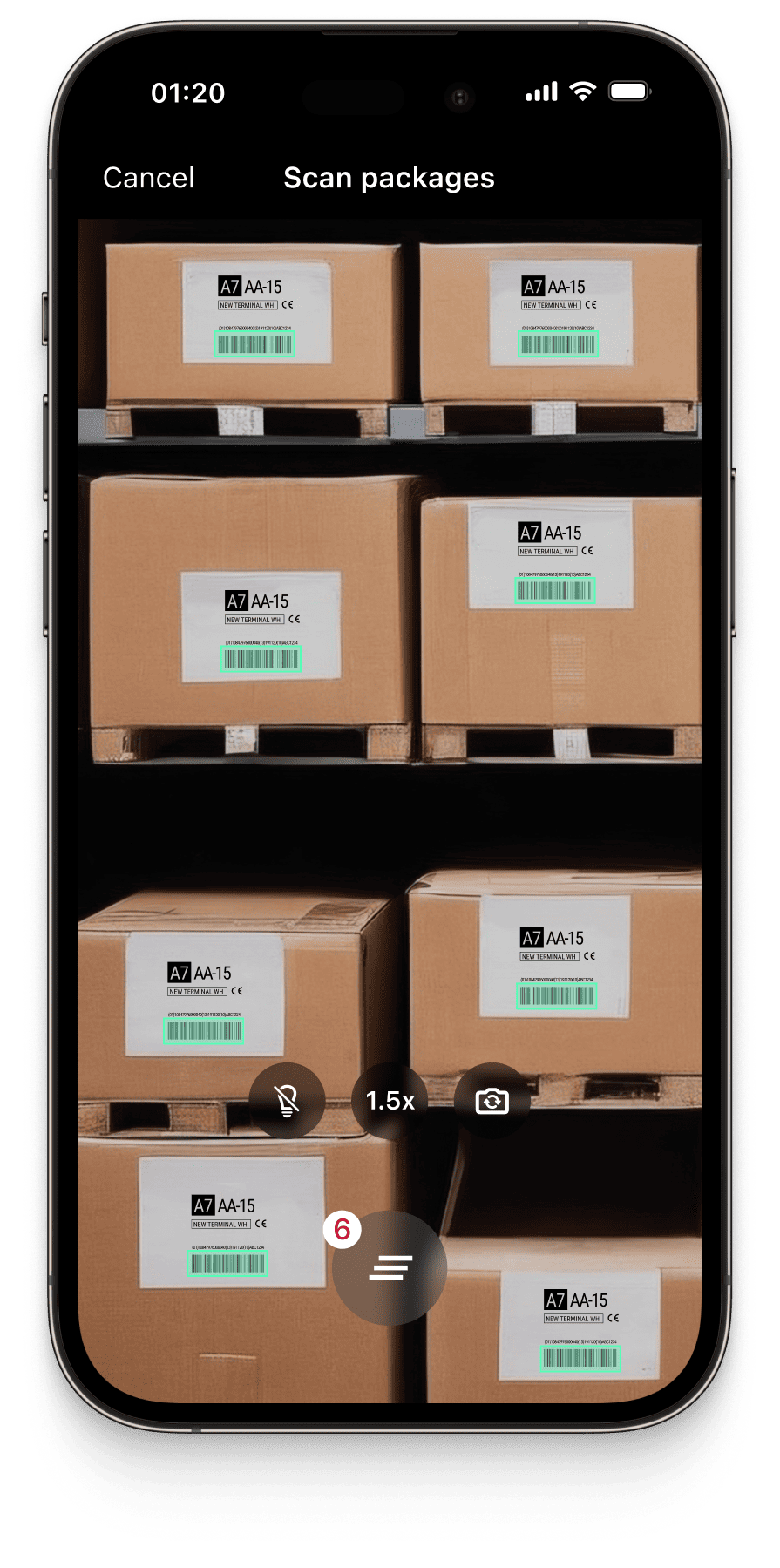
- Find & Pick: Searching for the right package from a jam-packed truck takes a lot of time. A Find & Pick feature enables your employees to pre-define desired barcode values that will then be highlighted in the live view.
- Data Capture: Certain products require age verification upon delivery. With integrated data capture software, your employees’ smartphones can scan different ID types and extract data from them, speeding up the verification process.
- Customizable user interface: A user-friendly interface is crucial for a friction-free adoption of a delivery app’s package scanner feature. This reduces the need for elaborate staff training and improves overall satisfaction.
- Offline capabilities: Online access is not a given on the road or in parcel sorting centers. A package scanner that works offline ensures seamless operations even in areas with limited or no network connectivity. The data can be synced as soon as connectivity is restored.
- Compliance with privacy regulations: Parcel labels bear sensitive personal data. A package scanner thus has to comply with regulations such as GDPR and CCPA – for instance, by working offline, without connecting to third-party servers.
Meet the Scanbot Barcode Scanner SDK
With the Scanbot Barcode Scanner SDK, your employees can scan all standard postal 1D and 2D barcodes in 0.04 seconds. The Scanbot Barcode Scanner SDK scans even damaged or blurred barcodes in poor scanning conditions, such as bad lighting – and without requiring an internet connection.
With the Scanbot SDK’s Ready-to-Use UI Components, you can set up a fully functional package scanner with a Find & Pick mode in just a few lines of code – even in a single, self-contained HTML file, thanks to the Scanbot Web Barcode Scanner SDK. Take a look:
<!DOCTYPE html>
<html lang="en">
<head>
<meta charset="UTF-8" />
<meta name="viewport" content="width=device-width, initial-scale=1.0, maximum-scale=1.0, user-scalable=0" />
<title>Find & Pick Package Scanner</title>
</head>
<body style="margin: 0">
<button id="scan-barcode">Scan barcode</button>
<script type="module">
import "https://cdn.jsdelivr.net/npm/scanbot-web-sdk@7.0.0/bundle/ScanbotSDK.ui2.min.js";
const sdk = await ScanbotSDK.initialize({
enginePath:
"https://cdn.jsdelivr.net/npm/scanbot-web-sdk@7.0.0/bundle/bin/barcode-scanner/",
});
document
.getElementById("scan-barcode")
.addEventListener("click", async () => {
const config =
new ScanbotSDK.UI.Config.BarcodeScannerScreenConfiguration();
const useCase =
new ScanbotSDK.UI.Config.FindAndPickScanningMode();
useCase.sheet.collapsedVisibleHeight = "LARGE";
useCase.sheetContent.barcodeItemImageVisible = false;
useCase.expectedBarcodes = [
{ barcodeValue: "A98765", title: "A98765, Scanbot SDK GmbH", count: 1 },
{ barcodeValue: "C23456", title: "C23456, Scanbot SDK GmbH", count: 1 },
];
config.useCase = useCase;
const scanResult = await ScanbotSDK.UI.createBarcodeScanner(config);
if (scanResult?.items?.length > 0) {
console.log(scanResult);
} else {
console.log("Scanning process canceled");
}
});
</script>
</body>
</html>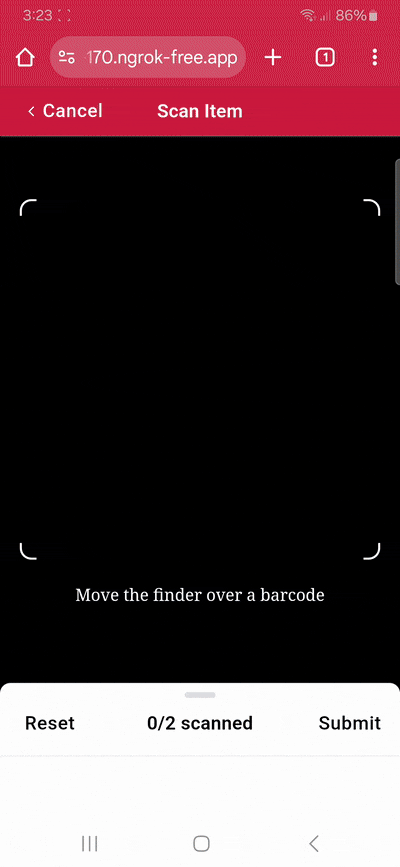
Feel free to copy the code into an HTML file, replace the expectedBarcodes values, and run it in your browser. When moving to production, we recommend you download the SDK and host it on your server instead of using a CDN.
You don’t have to worry about distance, as barcodes can be scanned from more than 1 meter away. On top of that, the Scanbot SDK’s user guidance features lead even less experienced couriers to the perfect scan. Experience the SDK for yourself in our free barcode scanner demo app. You don’t have to spend months developing a barcode scanning feature – integrating the Scanbot Barcode Reader SDK only takes a few hours. Feel free to contact sdk@scanbot.io to learn more about our solution.
FAQ
What types of barcodes and labels can smartphone-based package scanning process?
Can businesses use a mix of personal and company-issued smartphones for scanning (BYOD approach)?
A BYOD (Bring Your Own Device) strategy can be effective if proper security measures are in place. Companies should implement Mobile Device Management (MDM) policies to protect sensitive package data and ensure compliance with security regulations.
What are the security considerations when using personal smartphones for package scanning in a business environment?
The Scanbot Barcode Scanner SDK operates entirely offline, meaning all data processing occurs directly on the device. This ensures that sensitive personal information extracted from parcel labels is not transmitted to third-party servers, aligning with data protection regulations and best practices.
What steps should a business take to integrate smartphone-based scanning into its delivery operations?
Firstly, you will need to assess your operational needs and the barcode types that will need to be scanned. Then, select a barcode scanner software that is compatible with your operational needs and with your existing backend system to guarantee seamless integration. As a last step, train your employees. Thanks to their ubiquity, smartphones are easy to use, minimizing training time.
What type of smartphone specifications are needed for efficient package scanning?
Smartphones need modern barcode scanner software that enables efficient package scanning through features that speed up the workflow. The Scanbot SDK offers Multi Barcode Scanning and Batch Scanning, and reliably scans even damaged barcodes.
